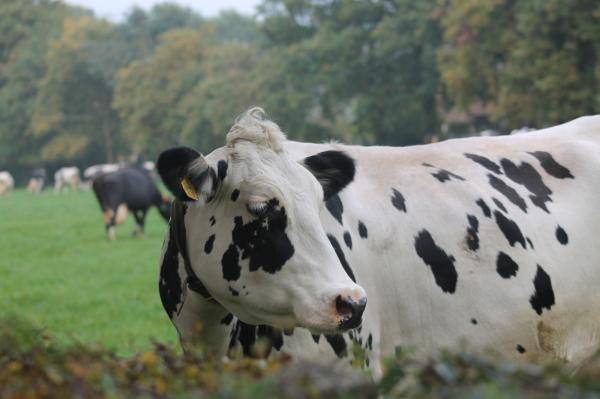Dairy farming is regularly in the spotlight as a result of the current nitrogen impasse in the Netherlands. A mandatory protein decrease is the feed discussion of the day in the Netherlands. The announcement of possible protein measures for the compound feed industry–in particular a maximum protein content in purchased concentrates and raw materials–is causing significant concerns for the sector. One of the possible ways to maintain cows' milk production and health with less crude protein is to formulate rations based on ileal digestible amino acids. For rations with a standard to high protein content (>16%), it was not necessary to take this into account until now. In the event of a mandatory drop in crude protein, however, nutritionists will also have to keep an eye on sufficient ileal digestible amino acids in the ration. In most rations, methionine is the most limiting amino acid.
Amino acids are essential nutrients. They are the building blocks for protein synthesis, which means they are essential for cows' maintenance needs (immunity, metabolism ...) and the production of milk protein. There are 20 different amino acids in total, eight of which are essential and must, therefore, be sufficiently supplied through the feed because they cannot be produced by the animal itself: lysine, methionine, threonine, isoleucine, phenylalanine, leucine, histidine and valine. When a shortage of at least one specific amino acid arises, it limits growth, milk production and maintenance.
More than 25 years of research has shown that methionine and lysine are the most limiting amino acids for protein synthesis in dairy cattle. For rations with a large proportion of grass silage, histidine is sometimes also considered to be limiting. In order to limit the loss of unused protein, we should aim for optimal balance of these digestible amino acids.
Ideal amino acid profile
IDP stands for ileal digestible protein; it is the protein that is available and digestible for the cow in the small intestine. It comes from ileal digestible microbial protein (IDMP) on the one hand and ileal digestible resistant protein (IDRP) on the other. Microbial protein has an amino acid profile that is very close to the ideal profile for the production of milk protein. A healthy rumen is an absolute must for maximum protein production.
Based on a dose-response approach, French researchers at INRA concluded as early as the early 90s that ileal digestible protein should contain approximately 7.3% lysine and 2.5% methionine for maximum milk protein production. Later, other researchers (NRC) more or less confirmed these optimal amino acid profiles with new studies and new calculation models. Critical lower limits of 6.8% for lysine and 2.1% for methionine were established based on practical and economic considerations.
Those who use the Dutch IDP system are advised to work with a minimum of 6.0% id. Lys/IDP and 2.15% id. Met/IDP. The difference with these recommendations has to do with some fundamental differences between the French and the Dutch protein rating systems for dairy cattle. In addition to a limiting amino acid for the production of milk protein, methionine also has a positive effect on cows' metabolic health during the transition. As a methyl donor, the amino acid contributes to relieving the burden on the liver (less fatty liver) and to better fertility. Highly productive cows (<60 DIM) in particular often do not meet the need coverage of id. Met and id. Lys.
Ration optimisation example
Today we optimise rations for IDP and DPB coverage. So in the future we will also have to keep an eye on id. Lys and id. Met. Below is an example for a 40-litre cow with 6.0% and 2.15% requirement for id. Lys and id. Met/IDP.
.png)
Rations with a reduced protein content in combination with high milk production and lower DM intake can become limiting for id. Lys and id. Met. In rations with lots of grass and corn silage, id. Met is the most limiting amino acid. If you add a lot of draff to your ration, then id. Lys also becomes more limiting.
Steering for a higher id. Lys/IDP (%) with concentrate can be done mainly with additional soybean meal. Raw materials with a higher id. Met/RDP balance include rapeseed meal, sunflower seed meal and corn gluten meal 60. When imposing additional restrictions on concentrates (e.g. max. crude protein), it is usually not possible to meet the requested standards without adding additional rumen-resistant amino acids.
Which rumen-resistant amino acids?
Today, only rumen-resistant methionine and rumen-resistant lysine are commercially available. There are different producers. Two important points for attention in making the right choice are: press stability and substantiation of the resistance/digestibility. Amino acids are made rumen-resistant by a type of coating. This coating should prevent the amino acids from breaking down in the rumen. As a result, the coated amino acids enter the small intestine, where they are absorbed into the blood.
In addition to coated methionine, there is also a rumen-resistant type based on the hydroxy analog of methionine (HMBi). 50% of HMBi is absorbed in the rumen and converted into methionine, the other half is used to form microbial protein in the rumen. This form is more suitable for pelleted feeds. For rumen-resistant lysine, we can only use coated forms. Tests show that there a difference in bio-availability (30 - 80%) exists between the different lysine products.
Conclusion
Increasing id. Met/IDP (%) in a concentrate is usually accompanied by a cost price increase. Based on the current prices for June 2020, a concentrate with 185 g/kg IDP and 3.2 g/kg id. Met (= 1.75% id. Met/IDP) becomes 5% more expensive when we increase the id. Met/IDP to 2.15%. The ultimate goal is to generate more milk protein with less feed protein, and metabolically healthier cows.
Working with ileal-digestible amino acids only makes sense if all other nutritional needs are met (FUM, IDP, DPB, roughage,...). And, needless to say, we should monitor that in the ration calculation program all values for id. Lys and id. Met of roughage, by-products and concentrates have been completed.
If you would like additional information about the formulation on id. amino acids in cattle, please contact your DSM Account Manager.


